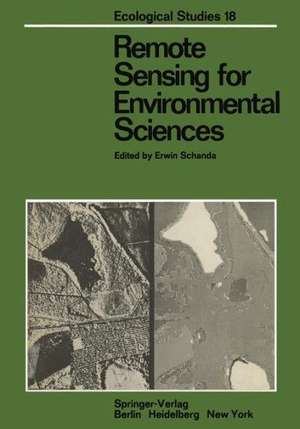Remote Sensing for Environmental Sciences: Ecological Studies, cartea 18
Editat de E. Schanda Contribuţii de R.T.H. Collis, D.J. Creasey, R.L. Grasty, P. Hartl, G.P. deLoor, P.B. Russel, A.E. Salerno, P.W. Schaperen Limba Engleză Paperback – 5 ian 2012
Din seria Ecological Studies
- 18%
 Preț: 1118.93 lei
Preț: 1118.93 lei -
 Preț: 553.71 lei
Preț: 553.71 lei - 18%
 Preț: 1680.55 lei
Preț: 1680.55 lei - 18%
 Preț: 1003.38 lei
Preț: 1003.38 lei - 20%
 Preț: 1004.69 lei
Preț: 1004.69 lei -
 Preț: 480.62 lei
Preț: 480.62 lei - 5%
 Preț: 752.26 lei
Preț: 752.26 lei - 15%
 Preț: 643.99 lei
Preț: 643.99 lei - 15%
 Preț: 644.18 lei
Preț: 644.18 lei - 15%
 Preț: 652.49 lei
Preț: 652.49 lei - 18%
 Preț: 789.83 lei
Preț: 789.83 lei -
 Preț: 382.36 lei
Preț: 382.36 lei - 15%
 Preț: 643.48 lei
Preț: 643.48 lei - 15%
 Preț: 646.30 lei
Preț: 646.30 lei - 15%
 Preț: 634.32 lei
Preț: 634.32 lei -
 Preț: 384.86 lei
Preț: 384.86 lei - 18%
 Preț: 789.98 lei
Preț: 789.98 lei - 15%
 Preț: 645.14 lei
Preț: 645.14 lei - 15%
 Preț: 649.39 lei
Preț: 649.39 lei - 18%
 Preț: 1005.43 lei
Preț: 1005.43 lei - 18%
 Preț: 949.23 lei
Preț: 949.23 lei - 15%
 Preț: 649.54 lei
Preț: 649.54 lei - 15%
 Preț: 643.34 lei
Preț: 643.34 lei - 15%
 Preț: 649.71 lei
Preț: 649.71 lei - 15%
 Preț: 638.76 lei
Preț: 638.76 lei - 18%
 Preț: 957.62 lei
Preț: 957.62 lei - 18%
 Preț: 1235.25 lei
Preț: 1235.25 lei - 18%
 Preț: 962.18 lei
Preț: 962.18 lei - 18%
 Preț: 949.23 lei
Preț: 949.23 lei - 15%
 Preț: 660.68 lei
Preț: 660.68 lei -
 Preț: 397.76 lei
Preț: 397.76 lei - 15%
 Preț: 638.24 lei
Preț: 638.24 lei - 18%
 Preț: 942.31 lei
Preț: 942.31 lei - 18%
 Preț: 1232.57 lei
Preț: 1232.57 lei - 15%
 Preț: 651.34 lei
Preț: 651.34 lei - 18%
 Preț: 952.72 lei
Preț: 952.72 lei - 18%
 Preț: 1834.27 lei
Preț: 1834.27 lei - 18%
 Preț: 1229.10 lei
Preț: 1229.10 lei -
 Preț: 423.95 lei
Preț: 423.95 lei - 18%
 Preț: 948.92 lei
Preț: 948.92 lei
Preț: 649.06 lei
Preț vechi: 763.60 lei
-15% Nou
Puncte Express: 974
Preț estimativ în valută:
124.20€ • 130.27$ • 103.39£
124.20€ • 130.27$ • 103.39£
Carte tipărită la comandă
Livrare economică 01-15 aprilie
Preluare comenzi: 021 569.72.76
Specificații
ISBN-13: 9783642662386
ISBN-10: 3642662382
Pagini: 388
Ilustrații: XIV, 370 p.
Dimensiuni: 170 x 244 x 20 mm
Greutate: 0.66 kg
Ediția:Softcover reprint of the original 1st ed. 1976
Editura: Springer Berlin, Heidelberg
Colecția Springer
Seria Ecological Studies
Locul publicării:Berlin, Heidelberg, Germany
ISBN-10: 3642662382
Pagini: 388
Ilustrații: XIV, 370 p.
Dimensiuni: 170 x 244 x 20 mm
Greutate: 0.66 kg
Ediția:Softcover reprint of the original 1st ed. 1976
Editura: Springer Berlin, Heidelberg
Colecția Springer
Seria Ecological Studies
Locul publicării:Berlin, Heidelberg, Germany
Public țintă
ResearchCuprins
1. Introductory Remarks on Remote Sensing.- 1.1 Application Areas of Remote Sensing.- 1.2 Sensing Systems.- 1.3 Remote Sensing and Spectral Constraints.- 2. Aerospace Photography.- 2.1 Introduction.- 2.2 Characteristics of Photographic Process.- 2.3 Cameras and Films.- 2.4 Photographic Attributes of Earth Sciences.- 3 Infrared Sensing Methods.- 3.1 Introduction.- 3.2 The Infrared Radiation Field.- 3.3 Fundamentals of Measurement.- 3.4 Methods of Measurement.- 3.5 Applications.- 3.6 Data Interpretation Error Sources.- 3.7 Expectations of the Near Future.- References.- 4 Laser Applications in Remote Sensing.- 4.1 Introduction.- 4.2 Fundamentals of Physical Processes Involved.- 4.3 Instrumentation.- 4.4 Applications.- References.- 5 Radar Methods.- 5.1 General Aspects.- 5.2 Backgrounds.- 5.3 Applications.- 5.4 Conclusion.- References.- 6 Passive Microwave Sensing.- 6.1 Principles of Passive Microwave Remote Sensing.- 6.2 Instrumental Aspects of Microwave Radiometry.- 6.3 Emissive Properties of Materials on the Surface of the Earth.- 6.4 Remote Determination of Atmospheric Constituents by Their Microwave Spectra.- 6.5 Passive Microwave Remote Sensing of Water, Ice and Snow.- 6.6 Investigations of the Soil, Vegetation and Geological Features.- 6.7 Investigations of the Atmosphere and of Meteorological Features.- References.- 7 Applications of Gamma Radiation in Remote Sensing.- 7.1 The Natural Gamma-radiation Field.- 7.2 Gamma-ray Detector Systems.- 7.3 Operational Procedures.- 7.4 Applications.- 7.5 Future Prospects.- References.- 8 Sonar Methods.- 8.1 Introduction.- 8.2 Propagation of Acoustic Energy.- 8.3 The Sonar Equation.- 8.4 Factors Affecting Resolution in a Sonar System.- 8.5 Applications.- References.- 9. Digital Picture Processing.- 9.1 Introduction.- 9.2 The Elements of an Image Data Processing and Analysis System.- 9.3 Geometric Corrections.- 9.4 Image Enhancement and Filtering Processes.- 9.5 Feature Extraction and Classification.- 9.6 Appendix 1: The Image Signal in Spatial and Frequency Domain.- 9.7 Appendix 2: Numerical Example for Texture-context Features.- References.- Color Plates.











